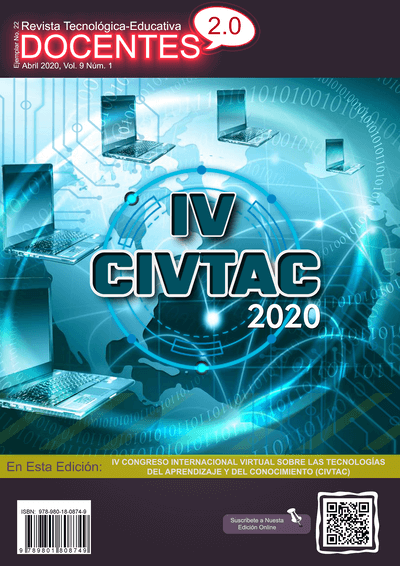The evaluation of learning mediated by TAC
 DOI:
https://doi.org/10.37843/rted.v9i1.98
DOI:
https://doi.org/10.37843/rted.v9i1.98
Main Article Content
Abstract
The present work aims to analyze the assessment instruments for learning mediated by Learning Technologies and the knowledge of a virtual training course for teachers at the primary level in the Province of Buenos Aires, Argentina. The use of the qualitative approach allowed to recover the reflections, thoughts and positioning of the teachers and tutors, as a product of the interaction in the virtual classroom. The evaluation indicators analyzed were content, activities, methodological strategies, evaluation instruments, the role of the students and the role of the tutor. The results obtained from the analysis of the data showed different resources that acted as pedagogical mediators. Regarding the conclusions, the pedagogical value of learning technologies and knowledge as mediators of the learning evaluation process is appreciated.
Downloads
Metrics
Article Details

This work is licensed under a Creative Commons Attribution-NonCommercial-NoDerivatives 4.0 International License.
Those authors who have publications in our journal accept the following terms:
- When a work is accepted for publication, the author retains rights of reproduction, distribution of his/her article for exploitation in all countries of the world in the format provided by our magazine and any other magnetic medium, optical, and digital.
- Authors will retain their copyright and guarantee the journal the right first to publish their work, which will be simultaneously subject to the Creative Commons Acknowledgment License (Attribution-NonCommercial-NoDerivatives 4.0 International (CC BY-NC-ND 4.0)). That allows third parties to copy and redistribute the material in any medium or format, under the following conditions: Acknowledgment - You must properly acknowledge authorship, provide a link to the license, and indicate if any changes have been made. You may do so in any reasonable way, but not in a way that suggests you have the licensor's endorsement or receive it for your use. NonCommercial - You may not use the material for a commercial purpose. NoDerivatives - If you remix, transform, or build from the material, you cannot broadcast the modified material. There are no additional restrictions - You cannot apply legal terms or technological measures that legally restrict you from doing what the license allows.
- Authors may adopt other non-exclusive license agreements to distribute the published version of the work (e.g., deposit it in an institutional archive or publish it in a monographic volume) provided that the initial publication in this journal is indicated.
- Authors are allowed and recommended to disseminate their work through the Internet (e.g., in institutional telematic archives, repositories, libraries, or their website), producing exciting exchanges and increasing the published work's citations.
- Request of withdrawal an article has to be done in writing by the author to the Editor, becoming effective after a written response from the Editor. For this purpose, the author or authors will send correspondence via e-mail: [email protected].
- The author will not receive financial compensation for the publication of his work.
- All Docentes 2.0 Journal publications are under the Open Journal System (OJS) platform at: https://ojs.docentes20.com/.
References
Barbera, E. (2006). Aportaciones de la tecnología a la e-Evaluación, RED. Revista de Educación a Distancia. (6), 1-13 Año 2006. https://revistas.um.es/red/article/view/24301Bossolasco, M. (2010). El foro de discusión. Entorno mediado
Chiva, I., Ramos, G., Gómez, M. B., y Alonso, A. (2013). E-learning assessment using the Aula Virtual platform at the University of Valencia. @tic. Revista innovación educativa (11), 60-68.
Flores, O. & del Arco, I. (2011). Los procesos de evaluación en asignaturas presenciales, semipresenciales y no presenciales de la Universidad de Lleida. opinión de profesorado y estudiantes. Revista Electrónica de Tecnología Educativa (37), 1-15.
Gibbs, G. (1999). Using assessment strategically to change the way students learn. In S. Brown & A. Glasner (eds.), Assessment Matters in Higher Education: Choosing and Using Diverse Approaches, Maidenhead: SRHE/Open University Press.
Marcelo, C y Pereyra, V (2007). Comunicación y aprendizaje electrónico: la interacción didáctica en los nuevos espacios virtuales de aprendizaje. Revista de Educación. (343),381-429.Quesada, R. (2006). Evaluación del aprendizaje en la educación a distancia “en línea”. RED. Revista de Educación a Distancia,5(6). 1-15.
Sandoval Casilima, C. (1996). Investigación cualitativa.Corcas.Siemens, G. (2005). Connectivism: A learning theory for a digital age. International Journal of Instructional Technology and Distance Learning, 2 (1). http://www.itdl.org/Journal/Jan_05/article01. htm
Zapata, M y Esteban, M. (2008). Estrategias de aprendizaje ye-learning. Un apunte para la fundamentación del diseño educativo en los entornos virtuales de aprendizaje. Consideraciones para la reflexión y el debate. Introducción al estudio de las estrategias y estilos de aprendizaje. RED. Revista de Educación a Distancia, (19).https://revistas.um.es/red/article/view/23941






